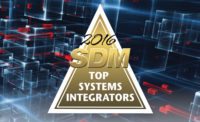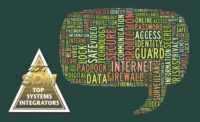It has been a long and arduous year since the U.S. Department of Health and Human Services, on January 31, 2020, issued its declaration of a public health emergency related to COVID-19. As the virus pillaged its way around the world, it caused commercial establishments within many segments to quickly shut their doors. As the months went on, businesses talked about reopening, while security companies examined technologies that could be used to help them safely do so.
One technology that came into the spotlight was thermal. The concept involves the use of a thermal “camera” or sensor to detect infrared radiation of a person being scanned and convert it into a temperature measurement. Despite some initial confusion about whether or not they should be FDA approved as medical devices (See related article, Taking the Temperature of Thermal Cameras) security integrators began studying and testing these EST devices, so-called because they produce an interpretation of a person’s elevated skin temperature. Since then they’ve learned a lot about how to make recommendations to customers, as well as important buying considerations such as shelf life, integration with other systems and cost.
At Detection Systems and Engineering, Troy, Mich., President and Co-Owner John Rathwell brainstormed with his marketing director, Bernie Youngblood, about how they could help their clients safely reopen their businesses. “We sat down and said, ‘Alright, how do we as a security integrator pivot now that this pandemic has hit our shores?’ We broke down what systems our commercial, industrial and municipal customers would need and we weren’t really even thinking of thermal technology at first,” Rathwell says, adding that their focus was on visitor management systems and automatic door openers.
“And then once the thermal cameras started coming out, our manufacturer partners started calling us — so we headed back to our list.” Detection Systems and Engineering did a marketing outreach campaign to its top 100 customers, explaining the available technologies that could enhance health and safety in the workplace. “We got really good feedback and that’s when we started scheduling demonstrations,” Rathwell says.
Wants & Needs
As Rathwell and other security integrators have found, at the core of every customer inquiry into an EST system is how their business can keep its doors open. “‘How do we not go bankrupt? How do we continue to make money?’ And to do that, you have to not only meet local, state and federal guidelines, but you also have an obligation to your customers to provide as safe of an environment as possible,” says Austin Flowers, Eastern regional accounts director, SSI (Surveillance Systems Inc.), Rocklin, Calif.
SSI has sold more than 100 systems, mostly to its large base of casino customers. “Every casino that I’ve been in has an EST solution of some kind,” he says. Characterizing the amount of revenue that a casino generates daily as “staggering,” a single day of lost revenue is a major setback. “Our customers needed to find as many solutions as possible to open up their casinos and keep them as safe as possible; and not just create an idea of safety — truly create as safe an environment as possible,” Flowers says, reminding that EST solutions do not detect COVID-19 but detect fever, which is just one of many common symptoms of the virus.
In addition to a traditional EST solution that uses a black-body reference device for continual calibration of the thermal sensor, some of SSI’s customers use fixed-temperature scanning stations for back-of-the-house applications. “It checks the temperature; it runs your facial biometrics against what is stored in the system. And for you to gain entrance, not only does your face have to match, but you have to be under a certain temperature,” Flowers describes.
Security integrators agree that not only are there a relatively large number of EST solutions on the market, but that they were announced much more rapidly than a new product set typically is introduced.
“Customers relied heavily on us for a recommendation,” says Aaron Simpson, president and CTO, Stone Security, Salt Lake City (SDM’s 2020 Integrator of the Year). “They were overwhelmed by the number of ‘solutions’ that were suddenly available. Stone did a significant amount of research around EST and narrowed it down to a couple viable primary screening methods that met FDA standards for the defined purpose.”
It isn’t only the vendors who rushed to market. Clients are rushing as well, to implement anything that makes them appear to be doing something in the name of safety. “We are seeing a subset of customers that are deploying this type of technology quickly, maybe even rushed, with unfortunately the primary driver being optics — perception — and not real, reliable, experienced technology,” says Dave Sweeney, general manager of Advantech, Dover, Del.
To help clients sort it all out, Advantech developed a good-better-best approach to the various solutions. The “best” approach was determined to be one manufactured by a company that had extensive experience in thermography before COVID-19 struck, as opposed to becoming a more recent authority on the technology. “Why wouldn’t you buy from somebody that was an expert in 2019?” Sweeney asks. “And usually those solutions and products carry an FDA approval of some sort and have a track record of expertise in this arena. Usually they have thermographers on staff. They’re really able to claim expertise.”
Life After COVID-19
A key factor that can help a security integrator sell EST cameras is their potential for a long shelf life. A client may have the mindset that business-as-usual will never return; therefore, temperature detection will be necessary well beyond the COVID-19 vaccination stage of this pandemic. But another contributor to shelf life is having a system that performs multiple functions and can be integrated with different systems.
One example is biometric readers that could work in a traditional access control environment, which ultimately gives them life after COVID, Sweeney describes. “Because to me that was a really important factor when you’re talking about making an investment. Is it a temporary investment or is it something that can work within my enterprise for years to come?
“I do believe the folks that aren’t thinking that through are going to have technology in their world that they no longer have the need for. But the folks that are thinking about this investment with some foresight are going to be able to re-deploy across their enterprise for enhanced authentication, maybe, or enhanced functionality for years to come. Because I think an off-shoot of a post-COVID world … is we’re going to be a lot more aware of things that we touch. Technology that’s being deployed to remove touching things, I think is going to have a life for a long time. Technology being deployed solely to measure elevated body temp I think is going to have a relatively short shelf life,” Sweeney contemplates.
The Protection Bureau, Exton, Pa., has sold EST systems to more than a dozen clients in sectors such as manufacturing, financial and Class A office buildings. “The ones that we’ve had the most success with were products that could integrate into existing access control systems and/or video systems, and then assist in getting the client more of a touchless type environment,” says J. Matthew Ladd, president and CEO at The Protection Bureau. “When someone enters their facility, can it unlock a door, open the door, notify somebody of a violation — whether it’s an elevated temperature or not wearing a mask. When we integrate into the access controls and the video systems the client is able to utilize a product down the road.”
Not all, but some EST systems can detect if a person is wearing a mask, and trigger an alarm or deliver a notification. Others apply facial recognition to a person wearing a mask so it can be integrated with an access control system. “When an authorized person walks up to a door into a facility, they will get their temperature measured,” Ladd says. “It will determine that they are wearing a mask and that they are the authorized person through facial recognition to enter into the facility. You’re kind of getting their best of all worlds in that case.”
If Daniel Jarrett, project manager, Netronix Integration, San Jose, Calif., had one piece of advice he could give to other security integrators it would be to do bench testing, especially to ensure they’re integrating EST systems as efficiently as possible.
“Test it at your office before you test it on-site with the customers. Make sure that you’re integrating these the best way for the customer. It’s not always a software integration that is best; sometimes using hardware integrations can go farther than software integrations,” he says.
Jarrett says that software integrations take time in computing for the intended actions to happen, whereas relay logic and hardware integration allowing the circuits to work together can create a faster solution. “The software isn’t always fast enough for the employees — they’ll say that it doesn’t work right when it has a half-second delay.”
Balancing Cost & Need
Some security integrators are less concerned about the long-term applications and integrations. Christine Lanning, president of Integrated Security Technologies Inc., Honolulu, made a specific recommendation to its banking customers to let the EST system it purchased operate in standalone fashion due to its country of manufacture and low cost.
“In this particular instance we told them not to put it on their network. So, they don’t have access to it other than just at that facility. The detection of the faces is all maintained and controlled in that one unit. It’s not connected to anything, so if for any reason it is phoning home to China (I don’t know how it would be because it’s not connected to anything), at least it would be limited in terms of what is sent back. Just use it for what it is, which is really just a separate device for the sole purpose of screening your employees as they enter the facility,” Lanning describes.
Not every customer wants a long-term solution, and Integrated Security Technologies’ banking customers are an example of that viewpoint. Lanning’s customer viewed EST cameras as a short-term solution for staying open. Therefore, the customer chose a relatively inexpensive product, one Lanning felt was not very reliable but fit the customer’s needs. Of the 15 units installed, three failed within the first month and had to be replaced, she notes.
“As a company you’ve got to evaluate the money that you’re spending and what you’re using it for, and you’ve got to create a return on investment,” Lanning says. “We helped this particular customer do that. And the cost of the more expensive units wasn’t justified.”
EST systems shouldn’t be considered the whole answer to a safe reopening. They must be considered along with other technologies and practices that lead to a healthy environment. But as one part of a comprehensive plan, Ladd says they are providing a peace of mind that says, “We’re doing everything we possibly can.”






